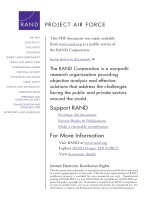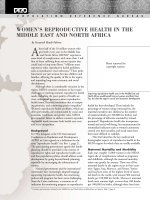the middle east a cultural psychology
Bạn đang xem bản rút gọn của tài liệu. Xem và tải ngay bản đầy đủ của tài liệu tại đây (4.32 MB, 471 trang )
The Middle East:
A Cultural Psychology
Gary S. Gregg
OXFORD UNIVERSITY PRESS
The Middle East
series in culture, cognition, and behavior
series editor
David Matsumoto, San Francisco State University
series advisory board
Deborah Best, Wake Forest University
Michael Harris Bond, Chinese University of Hong Kong
Walter J. Lonner, Western Washington University
The Middle East: A Cultural Psychology
gary s. gregg
The Middle East
A CULTURAL PSYCHOLOGY
Gary S. Gregg
With a Foreword by
David Matsumoto
1
2005
3
Oxford University Press, Inc., publishes works that further
Oxford University’s objective of excellence
in research, scholarship, and education.
Oxford New York
Auckland Cape Town Dar es Salaam Hong Kong Karachi
Kuala Lumpur Madrid Melbourne Mexico City Nairobi
New Delhi Shanghai Taipei Toronto
With offices in
Argentina Austria Brazil Chile Czech Republic France Greece
Guatemala Hungary Italy Japan Poland Portugal Singapore
South Korea Switzerland Thailand Turkey Ukraine Vietnam
Copyright © 2005 by Oxford University Press, Inc.
Published by Oxford University Press, Inc.,
198 Madison Avenue, New York, New York 10016
www.oup.com
Oxford is a registered trademark of Oxford University Press
All rights reserved. No part of this publication may be reproduced,
stored in a retrieval system, or transmitted, in any form or by any means,
electronic, mechanical, photocopying, recording, or otherwise,
without the prior permission of Oxford University Press.
Library of Congress Cataloging-in-Publication Data
Gregg, Gary S.
The Middle East : a cultural psychology / by Gary S. Gregg.
p. cm. (Series in culture, cognition, and behavior)
ISBN-13 978-0-19-517199-0
ISBN 0-19-517199-3
1. Ethnopsychology—Middle East. 2. Personality and culture—Middle East.
3. Islam—Psychology. 4. Religion and culture—Middle East. I. Title. II. Series.
GN502.G76 2005
155.8'2'0956—dc22 2004016417
987654321
Printed in the United States of America
on acid-free paper
Recent years have witnessed an explosion in information technology. Schol-
ars and scientists in all fields of study have at their fingertips more informa-
tion than ever before and, in fact, more information than they can possibly
manage. We are able to communicate and interact with others around the
world effortlessly via the Web. Interest and research on people from differ-
ent cultures and societies is at its highest in recent decades, and promises to
become even more prominent in the future.
Despite the information explosion and increased ease of communication,
there are still countries, regions, and cultures of the world about which we
have little reliable information. Although studies of culture and psychology
are prominent in the Far East (particularly Japan), North America, and Eu-
rope, they are still sorely lacking in Central and South America, Africa, South-
east Asia, and the Middle East. This gaping hole in the scientific literature is
in fact largest in psychology, as psychological studies of the people of these
cultural regions still lag far behind other types of scientific research.
The consequences of this lack of information are formidable. People’s
reactions to the events of September 11 demonstrated that ignorance
about
the lives of people from other cultures helps to promulgate stereotypes, mis-
perceptions, and misunderstandings. Believing in uninformed stereotypes
makes it easier to make negative attributions to groups of people when un-
fortunate events occur. Doing so also makes it easier to homogenize people,
ignore their considerable individuality and diversity, and believe in the su-
premacy of one’s ways of life, beliefs, and being.
It is in this light that I welcome Gary Gregg’s The Middle East: A Cul-
tural Psychology as the first book to be published in the Oxford University
Press Series in Culture, Cognition, and Behavior. In this book, Gregg pro-
vides a broad overview of what underlies the psychological development
throughout the lifespan of individuals living in Middle East and North African
foreword
(MENA) societies and cultures. Through his discussions of pediatric styles
of childcare, the honor-modesty system, Islam, the tension between tradi-
tion and modernity, and the development of self and identity, Gregg does an
outstanding job of highlighting aspects of development that appear to be simi-
lar panculturally—universal to all people of all cultures—as well as those that
appear to be unique to the MENA region. Moreover, the work presented in
this volume represents not only Gregg’s own research, but also his under-
standing—remarkable in its breadth and depth—of all the relevant cross-
cultural, cultural, and developmental literatures. He deftly crafts his message,
juxtaposing the available scholarly literature from Europe and North America
on questions and concerns about development with the concepts and mate-
rial generated from his primary research on real-life MENA people.
There are several characteristics of this book that make it unique. For
example, Gregg spends the first two chapters describing the social ecology of
the region, which gives readers an excellent feel for that ecology and, more-
over, for the general sociocultural milieu within which individuals in MENA
live, work, and play. It is important background information that is not often
available to cross-cultural, cultural, and mainstream psychologists today.
Gregg’s attention to concepts such as nomadism, peasant agriculture, urban
commerce, and the widespread adoption of Arab culture and Islam provides
a crucial context for understanding the material
in the main sections of the
book. This type of background material should be provided by every work
on the psychology and development of any group of people in any area of
the world and against which extracted psychological constructs should be
interpreted and connected.
Gregg is not an armchair psychologist. In this day and age, psychologists
interested in the cultural context of behavior can carry out their research at
home in front of a computer, but Gregg chose to interact directly with the
populations he is studying. Gregg’s work is also unique because it brings the
methodology of the study of lives tradition to the area of culture and psychol-
ogy. He follows in the outstanding heritage of Erikson, Mead, Murray, Levine,
and McAdams to go beyond simple verbal responses to questionnaires or
behavioral responses to tasks by conducting comprehensive, in-depth, quali-
tative studies of the lives of numerous individuals living in MENA. More-
over, he brings the complexity, richness, and sometimes conflicting aspects
of individual lives alive to the reader, all the while extracting psychological
constructs and concepts that are vital to a complete understanding of their
cultural psychological development.
Gregg’s work is also notable in the theoretical frameworks of personality
he uses. Although many views of personality in studies of culture today are
dominated by the trait approach, Gregg revives the notion of different levels of
personality organization. His three levels of psychological organization—cor-
responding to biological, social, and cultural influences—underscore the im-
portant fact that individual lives are complex, multilayered, and multifaceted.
vi Foreword
The notions of sentiments, motives, and social personae are interesting, unique,
and informative not only as theoretical contributions to the study of the psy-
chology of MENA but also to all who are interested in the interaction between
culture, personality, mental processes, and individual behavior.
Needless to say, Gregg’s work makes numerous contributions—theoreti-
cally, empirically, and pragmatically. The two contributions that stand out
in my mind are the messages he brings to the concepts of Individualism ver-
sus Collectivism (IC) and to contemporary studies of self and identity. He
demonstrates amply that stereotypical descriptions of cultures (and, more-
over, of individuals) as either individualistic or collectivistic are just too sim-
plistic and most likely inappropriate. Gregg clearly shows that cultures have
both individualistic and collectivistic tendencies, and that future theoretical
and empirical research needs to work through this simple and perhaps mis-
leading dichotomy. Gregg’s research adds to a growing literature that sug-
gests that selves and identities are comprised of a repertoire of schemata,
including both independent and interdependent concepts, and that culture
influences the content of these schemata via the contexts of the lives within
which individuals develop. Despite the stereotypic and oversimplistic view
of MENA cultures as being collectivistic, the individual lives of the people
Gregg studied are incredibly rich, diverse, and full of fledgling individuality
and autonomy. I agree with Gregg in his suggestion that oversimplified no-
tions of independent/individual self-construals versus interdependent/socio-
centric border on academic stereotyping, not unlike that done by political
leaders throughout history to justify outright discrimination and aggression
toward others. It is a path that concerned social scientists should not take,
and one that Gregg’s work argues against admirably.
Additionally Gregg’s book is valuable because it makes available an in-
teresting and important literature—two thirds of it by Arab-Muslim schol-
ars—available to Western researchers and the informed public. And it helps
us better understand Middle Easterners by seeing how they struggle to mod-
ernize their traditions without simply abandoning them for Western ones.
The life span developmental framework that Gregg uses is perfect in high-
lighting these issues and concerns.
Gregg is a gifted writer; he brings the material to the reader as a novelist
would bring life to characters, or as any artisans working their craft. The theo-
retical perspectives on culture, personality, self, identity, and development;
empirical contributions of the study of lives approach; and the carefully
crafted writing make this volume one that is sure to make a strong and last-
ing contribution to the scholarly literature on culture, psychology, and the
Middle East/North Africa. This book is a befitting start to Oxford’s Series in
Culture, Cognition, and Behavior.
David Matsumoto
San Francisco
Foreword vii
This page intentionally left blank
This book had its inception in the seminar I taught on “Psychological Stud-
ies of Arab-Muslim Societies” at Harvard’s Center for Middle Eastern Stud-
ies, and I thank Professors Susan Miller, Robert LeVine, Byron Good, and
Mary-Jo Good there for their support.
Research for the book was supported by a sabbatical leave from Kalamazoo
College in the 2002–2003 academic year. A Visiting Scholar appointment and
a Mellon Grant made it possible to work at the University of Michigan’s Cen-
ter for Middle Eastern and North African Studies, and a Fulbright Fellowship
supported crucial library research in Egypt and Morocco. Thanks to Profes-
sor Maissa el Mofti for welcoming me to ‘Ain Shems University in Cairo and
for many helpful conversations, and to Professor Farouk Sendiony and Eliza-
beth Coker at the American University in Cairo. Thanks also to Professor
Mohammed Ezroura for welcoming me to Mohammed V University in Rabat,
and to Dr. Mehdi Paes and Dr. Jamal Toufiq at the Ar-Razi Hospital in Sale
(Rabat) for guidance early in my work there.
Great thanks to the Arabic tutors and research assistants who worked
with me over the last three years: Laila al-Duwaisin (from Kuwait) and Faisal
Shurdom (from Jordan) at Kalamazoo College, Yasmeen Hanoosh (from
Iraq) and Marwan Gammash (from Saudi Arabia) at the University of Michi-
gan, Ali Fadhel (from United Arab Emirates) at Western Michigan University,
Hala Mahmoud in Cairo, and Laila Rabi’a in Rabat. Also to my Kalamazoo
College students Shadi Houshyar, Natasha Ghazi, Maya Farhat, and Anna
Maxbauer for bibliographic and library help, and for insightful comments
on early drafts. Hala Mahmoud also deserves credit as coauthor of the sec-
tion on indigenous psychology that appears in the Afterword.
Special thanks to Susan Schaefer Davis and Douglas Davis for their
fine research, friendship, and patient encouragement of my work. And
to Alison Geist for five years of collaborative work in Morocco, which she
acknowledgments
used to create more immediate and tangible results than I: the Near East
Foundation-sponsored project now active in 40 villages, improving fam-
ily nutrition, water sanitation, fuel-wood stove efficiency, and women’s
literacy.
Note on Photos
All photos were taken by Gary Gregg and Alison Geist in southern Moroc-
can villages that continue to practice nonmechanized agriculture and herd-
ing of sheep, goats, and camels on the slopes of the High Atlas mountains.
Few Middle Easterners today live in “traditional” settings like these.
x Acknowledgments
contents
introduction 3
part I
Cultural Context of DevelopmentCultural Context of Development
Cultural Context of DevelopmentCultural Context of Development
Cultural Context of Development
1 Misunderstandings 13
2 The Social Ecology of Psychological Development 44
3 Honor and Islam: Shaping Emotions, Traits, and Selves 90
part II
Periods of Psychological DevelopmentPeriods of Psychological Development
Periods of Psychological DevelopmentPeriods of Psychological Development
Periods of Psychological Development
introduction to part II 136
4 Childbirth and Infant Care 153
5 Early Childhood 179
6 Late Childhood 212
7 Adolescence 252
8 Early Adulthood and Identity 288
9 Mature Adulthood 325
10 Patterns and Lives: Development Through the Life-Span 359
afterword: A Research Agenda 369
notes 379
references 421
index 451
The Middle East
This page intentionally left blank
introduction
3
Since I began writing this book, the escalation of Israeli-Palestinian strife, the
attack on the World Trade Center, and the wars in Afghanistan and Iraq have
put the Middle East even more prominently onto the center stage of world
history. Samuel Huntington has ominously predicted that the twenty-first
century would see a “clash of civilizations” pitting Islam against the West,
and Samuel Barber described globalization as culminating in a struggle of
“Jihad versus McWorld.” I hope this book might help put the daily headlines
in a broader perspective, by describing psychological dimensions of traditional
ways of life in Middle Eastern and North African societies, and of the impact
of “modernization” and “underdevelopment.” It will not offer psychologi-
cal explanations for the region’s economic and political problems, or for the
Israeli-Palestinian conflict. But it will consider what Arab social scientists have
been writing about the inner consequences of economic stagnation and po-
litical despotism, and about Middle Easterners’ current attempts to “become
modern” while conserving what they see as their authentic traditions.
The following chapters cover nearly all writings on the cultural psychol-
ogy of Middle Eastern Muslim societies, and examine the patterns of psycho-
logical development, attachments, values, and identities that appear to be
distinctive of the region. This work began when I first taught a seminar en-
titled “Psychological Studies of Middle Eastern Societies” and discovered that
there was no summary of the region’s cultural psychology I could assign my
students, no review of the interesting studies I’d been reading, and not even
a bibliography. As a result, the region is usually not covered in the cultural
psychology courses now taught in most colleges and universities, and is rarely
discussed at conferences of cross-cultural psychologists. Worse, Americans
interested in learning about the area’s cultural psychology find little other
than ethnocentric writings on “the Arab mentality” that mistakenly attribute
the Middle East’s recent problems to the inertia of deep-seated psychologi-
cal characteristics. I have therefore written this book with two purposes in
4 Introduction
mind: first, to provide cross-cultural researchers and students with a review
of writings on psychological development in the Middle East; and second, to
provide Westerners with psychological perspectives on the inner lives of
Middle Easterners as they face a rapidly globalizing world, most of them liv-
ing in conditions of economic and political “underdevelopment.”
The book draws on my own background and experience. Trained as a
personality psychologist in the “study of lives” tradition, I studied the devel-
opment of identity among young adult Americans, and then spent five years
in the 1980s in Morocco, conducting ethnographic research on the Berber-
speaking Imeghrane confederation in the High Atlas and pre-Saharan area
of Ouarzazate, and then life-history studies of identity among young adults
living in villages and small towns. My synthesis of psychological writings is
guided by my observations and interviews with over a hundred families in
that region, and by my research on how individuals live their simultaneously
modernizing and underdeveloping culture.
The Middle East as a “Culture Area”
My review includes research on Muslim groups from Morocco to Pakistan
and Turkey to Sudan—a huge and complex area whose cultures have been
formed by millennia of mixing peoples, languages, ways of life, and religions.
No homogenous shared culture—and certainly no shared “personality” or
“mentality”—has resulted from this mixing. Nonetheless, I will discuss it as
a culture area. This notion—and even the concept of “culture”—has come
under increasing criticism as globalizing peoples, products, and ideas flow
and mix with dizzying speed. I agree with these criticisms, and with the call
to shift from studying the world’s “cultures” to the process of “hybridization”
that is taking place everywhere.
1
But I believe that centuries of mixing three ways of life—nomadism,
peasant agriculture, and urban commerce—in arid and semiarid lands, com-
bined with the widespread adoption of Arab culture and Islam, have formed
a “culture area” with distinctive patterns of development from infancy to old
age. Abdelhamid Jabar’s study of psychological needs in three Arab societies
(chosen to reflect the historical importance of nomadic versus urban ways
of life) led him to a similar conclusion.
2
The anthropologist Sherry Ortner
and the Turkish historian Deniz Kandiyoti argue that the extended family
systems found in the band of societies stretching from North Africa into China
and India share “patriarchal” principles found in few other of the world’s
cultures.
3
These differ from each other in the way that “classic patriarchy”
4
has combined with agro-pastoralism and Islam in the Middle East, with the
caste system and Hinduism in India, with rice agriculture and Confucianism
in China, and with feudalism and Christianity in Europe—thereby forming
four of the world’s “Great Tradition” civilizations.
Introduction 5
The Egyptian psychologists Khalifa and Radwan discuss the existence
of common Arab psychological characteristics at length in their 1998 Al-
shakhsiyyia al-misriyya (The Egyptian Personality) and conclude that the
long interplay of culturally unifying forces has led to the sharing of some
features throughout the region. Several survey studies support this view.
5
At the same time, differences appear in three subregions (the Persian Gulf,
the Nile, and North Africa) and among individual nations. And through-
out the Middle East, urban, rural, and Bedouin styles of life have created
additional variation.
6
I have no doubt that the “culture area” concept brings
a danger of oversimplification, and as Khalifa and Radwan point out, re-
cent decades of population growth and economic change are probably
reducing the extent to which Middle Eastern societies share a cultural psy-
chology. I nonetheless believe we cannot dispense with the culture area
notion, especially insofar as it helps understand the history by which fam-
ily systems and life-patterns have evolved, and the hybridization that now
affects every resident of the region.
The American anthropologists who developed the culture area notion
in the 1920s and 1930s did so after analyzing the borrowing and refashion-
ing of “culture traits” among native North American tribes. They never saw
cultures as isolated and self-contained, and they did not think clear bound-
aries could be drawn between adjacent culture areas. They did believe that
a predominant vision of life comes to guide a culture’s borrowing (and
rejection) of concepts, tools, and customs from their neighbors, and to guide
how it revises these to fit its own conditions and worldview. But they also
recognized that even small “simple” cultures encompass variations on their
main themes and have individuals who at least try to live by divergent styles.
Far from portraying a culture as homogeneous and cut off from its neigh-
bors, the culture area concept can help (1) recognize patterns of psycho-
logical development that this region shares with neighboring culture areas
(sub-Saharan Africa, Hindu India, and preindustrial southern Europe); (2)
identify patterns that differ from those of neighboring areas; and (3) do
justice to the great range of variation (male-female, urban-rural, country-
to-country, and individual-to-individual) observed within the region. View-
ing the region in comparison with its neighbors also helps take an important
step away from ethnocentrically seeing it in the light of American middle
class values.
Still, the “culture area” cannot be precisely defined. Studies from coun-
tries on the borders of the region—especially Turkey, Pakistan, Iran, and
Sudan—suggest that in some respects they can be considered to be “in” the
culture area but in other respects they fall “outside” it. Citizens of these bor-
der lands are correct to insist that they have distinct histories, customs, and
outlooks that set them apart from other peoples in the region. Egyptians,
Palestinians, Saudis, and others located in the region’s core are equally cor-
rect to make the same claim. And during the last 50 years, dramatically dif-
6 Introduction
fering forms of government have further increased cultural divergence. Still,
the societies in this region share many characteristics with each other that
they do not share with neighboring regions. I intend my definition of this
“culture area” to be only a useful approximation that can serve as a bridge to
closer study of the variations within it. In order to further simplify the book,
I will not cover studies of Muslim Arabs living outside the region, or studies
of Israel, or research on Jews, Christians, or Bahais living in majority-Mus-
lim lands. The book also will not do justice to the important differences be-
tween Sunni and Shi’ite Muslims, or to the cultures of ethnic minorities, such
as Berbers, Tuaregs, Druze, and Kurds.
I will, however, continually emphasize the diversity within the region. I
adopt a notion of “culture” which views it not as a way of life shared by all
those who live in it but as a constellation of values, meanings, and practices
unevenly distributed to its members.
7
In addition, each chapter will discuss
differences between men and women, and between more traditional and more
modernized milieus. Personality may indeed appear as “culture writ small”—
as an internalization of one’s culture—but individuals have surprising lati-
tude to select the elements of their heritage they regard as “their” culture,
and to synthesize them in creative and idiosyncratic ways.
There remains the difficult problem of what to call this culture area. Only
parts of it are “Arab”; it is only a part of the “Muslim” world; and “Middle
East” usually refers to the countries of the eastern Mediterranean and Per-
sian Gulf. In the book’s first draft I used “Middle East” as the best of these
inappropriate terms. But several Egyptian colleagues have convinced me to
replace it with the awkward acronym MENA: Middle East and North Africa.
While MENA is still not fully accurate, it has the advantage of not being a
household word loaded with media stereotypes. It thus may help remind the
reader that the culture area does not correspond to any of the primary iden-
tities—for example, “Arab,” “Muslim,” “Middle Eastern,” “Saudi,” “Alge-
rian”—embraced by those who live within it.
Plan of the Book
Chapter 1 discusses the stereotypes Westerners have developed about the Arab
world, and examines five common misunderstandings of MENA societies that
have been offered as explanations for the region’s current problems. The next
two chapters provide the background or “social ecology” of psychological
development, summarizing studies of MENA social organization (chapter 2)
and cultural values (chapter 3). The introduction to part II presents the model
of cultural influences on personality development I use to synthesize the lit-
erature, and chapters 4 through 9 cover writings on psychological develop-
ment by life-stage: infancy, early childhood, late childhood, adolescence, early
Introduction 7
adulthood, and mature adulthood. The final chapter provides a brief review
of development across the life-span.
Given the size and importance of MENA, there is surprisingly little re-
search on psychological development. Several widely read works, like The
Arab Mind, by Raphael Patai, and The Closed Circle, by David Pryce-Jones,
take highly ethnocentric “national character” approaches, treating Arabs as
if they were a single person who could be put on an analyst’s couch. (The
2002 edition of Patai’s book features an introduction by Colonel Norvell De
Atkine, director of Middle Eastern studies at the U.S. army’s John F. Kennedy
Special Warfare Center and School, who writes enthusiastically that “at the
institution where I teach military officers, The Arab Mind forms the basis of
my cultural instruction.”)
8
Several of the most interesting, like Fuad Khuri’s
Tents and Pyramids, Abdelwaheb Bouhdiba’s Sexuality in Islam,
9
Hamed
Ammar’s Fi bina’ al-bashar (On the Building of Persons), Ali Zayour’s Al-
tahlil al-nafsi li-al-dhat al-’arabiyyah (Psychological Analysis of the Arab Self)
and Mustafa Hijazi’s Al-takhaluf al-ijtima’i (Societal Underdevelopment), are
works of social criticism by MENA scholars which also examine the “Arab
mentality.” In addition, few MENA psychologists have participated in the last
two decades’ growth of “cultural” and “cross-cultural” psychology. This is
due partly to their efforts to meet more urgent priorities, and partly to eco-
nomic constraints.
10
The cost of the mostly Western journals and books in
this area is prohibitive to many researchers and university libraries,
11
and as
Omar Khaleefa points out, attending an international conference can cost
several years’ salary.
12
In spite of serious economic and often political obstacles, researchers have
carried out valuable field studies of child-rearing practices and of the forces
shaping adolescent and adult development.
13
These studies lay out provoca-
tive debates about cultural influences on development and show important
lines of convergence. Each of the life-stage chapters will end by highlighting
a debate or disagreement which appears in the literature: the effects of strongly
“interdependent” nurturing during infancy and its often abrupt withdrawal;
the gender differentiation which intensifies near the end of early childhood,
often coincident with circumcision;
14
the shift to possibly “authoritarian”
styles of parenting in late childhood; the smoothness versus turmoil of ado-
lescent maturation; the tension between Western and indigenous identities
in early adulthood; and the relationship of societal and psychological devel-
opment in mature adulthood.
Because I am writing partly for readers who may be learning about MENA
societies for the first time, I make occasional use of autobiographies and novels
to help bring patterns and numbers more vividly to life. This book does not,
however, review the broad discipline of psychology in the region,
15
or cul-
tural influences on mental illness and psychiatry. Two recent books provide
excellent English-language introductions to these topics: Ramadan Ahmed
8 Introduction
and Uwe Geilen’s Psychology in the Arab World (1998) and Ihsan Al-Issa’s Al-
Junun: Mental Illness in the Islamic World (2000).
Theoretical Framework
To synthesize psychological studies of MENA I employ a framework based
mainly on dynamic theories of personality development, especially those of Erik
Erikson,
16
John and Beatrice Whiting,
17
Robert LeVine,
18
and Dan McAdams.
19
I also draw on Takeo Doi’s writings on Japan,
20
Gannanath Obeysekere on Sri
Lanka,
21
Sudhir Kakar and Ashis Nandy on India,
22
and Gilbert Herdt on New
Guinea.
23
These differ from what Whiting terms “as-the-twig-is-bent” theo-
ries, which view development as a continuous process guided by reward, pun-
ishment, and the modeling of appropriate behavior (“social learning theory”
is the leading example). While some aspects of development certainly are con-
tinuous, dynamic theories emphasize the importance of biologically and cul-
turally patterned discontinuities: transitions in which established patterns of
emotion, relationship, and self-conception must be transformed or suppressed
in order to acquire new ones. The dynamic theories recognize that (1) devel-
opmental transitions often entail inner and interpersonal conflict, and that
(2) earlier patterns may remain part of the new organization, and sources of
tension within it. For Erikson, these discontinuities form the “developmental
tasks” that define stages of human development.
I have divided the life-span into six developmental periods, condensing
Erikson’s eight-stage schema,
24
but I do not regard these periods as discrete
“stages” with the timing and content he theorizes. I also distinguish three levels
of psychological organization which emerge in succession, in adaptation to
changing biological, cognitive, and cultural influences.
25
This model makes
it possible to move beyond generalizations about “culture and self” to begin
identifying cultural practices which have their main effects during specific
developmental periods and influence specific levels of psychological organi-
zation. I sketch this model in chapter 3, where I discuss how we can best con-
ceptualize the psychological consequences of “internalizing” the region’s two
primary value systems, and I then discuss it more fully in the introduction to
part II.
My choice of this framework has two important consequences. First,
while it is designed to account for cultural differences, it remains a West-
ern theory of development whose applicability to MENA societies remains
to be judged. Psychologists in many non-Western societies have criticized
the importation of Western theories and sought to create “indigenous” psy-
chologies which draw on their own traditions. Ahmed and Gielen call for
this kind of “indigenization,” for which the works of the Lebanese psychia-
trist Mohammed Nablusi (Nahu saykulujiya ‘arabiah [Toward an Arab Psy-
chology]) and the Egyptian psychologist Fuad Abu Hateb (Mushkilat ‘ilm
Introduction 9
al-nafs fi al-’alam al-thaleth hala al-watan al-‘arabi [Problems of Psychol-
ogy in the Third World and the Arab Countries]) lay out blueprints.
26
By
bringing together previous psychological studies (over two-thirds of them
by MENA researchers) and putting them in a global context, I hope this
Westerner’s book may contribute to that project.
Second, I will pay relatively little attention to what many American text-
books now feature as the core of cultural psychology: studies of the effects of a
culture’s “cognitive schemas” on self-conceptions. This is because (1) little of
that research has been done in MENA societies: (2) I believe it gives too much
emphasis to cognition and too little to emotion and interpersonal relationships:
and (3) it fails to take account of developmental discontinuities. Further, I be-
lieve much of this work—especially research based on scoring cultures on the
dimension of “individualism” versus “collectivism”—to be especially inappro-
priate to the region, which, as Cigdem Kagitcibasi and Suad Joseph argue, has
strong individualist and collectivist features.
27
I will, however, draw on other
recent work in cultural psychology, especially that on culture-and-emotion, that
shows that a set of universal emotions are shaped by each culture in accordance
with its distinctive rules for displaying feelings.
28
I also will draw on recent stud-
ies of acculturation which show that the formation of multiple or “hybrid”
identities is widespread and often adaptive. Both of these lines of research can
account for discontinuity and tension in development.
Above all, I will not put MENA culture or character on the couch, for
in no respect can the region be said to have a shared “basic personality.”
The life-history interviews I conducted in Morocco show not only a tre-
mendous range of individual variation but also that the culture is not so
much shared by those who live in the region as distributed among them.
Different features are apportioned to men and to women; to the old and to
the young; to city dwellers and to villagers or nomads; to the educated and
to the illiterate; and to pious believers and to those who have strayed. Even
within families, individuals internalize versions of their culture so diver-
gent that they get in the way of understanding each other’s lives. Culture is
not to be found in a static system of shared values or meanings, but lives in
patterned dialogues and debates about values and how they should be lived.
The framework I adopt—based on six developmental periods and three
levels of psychological organization—will help describe major cultural in-
fluences without minimizing the tremendous variety in individual adapta-
tions to them. It also will help to examine how the two-sided process of
societal “modernization” and “underdevelopment” is shaping the develop-
mental tasks faced at critical periods in the life-course, and how the cul-
tural dualities stemming from Western dominance of the globalizing world
are affecting the course of individual lives.
At the beginning, however, it is important to consider the many ways
Westerners have misunderstood MENA cultures and psyches, which is the
subject of the first chapter.
10 Introduction
A Note to Readers
I have written this book to be read cover to cover, with each chapter building
on the previous ones. But for those who plan to read only parts of it, and for
teachers who wish to assign selected chapters to their students, a brief over-
view of each chapter appears at its beginning. If you plan to read only some
chapters, I recommend also reading the overviews of the others.
part I
Cultural Context
of Development
This page intentionally left blank









